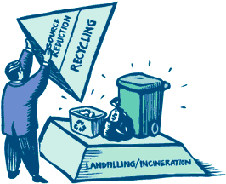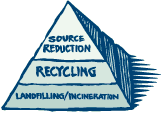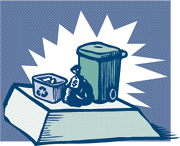State Officials
More Fact Sheets
Introduction | What is pay-as-you-throw? | Benefits | Disadvantages | Learn More
Fact Sheet
EPA530-F-96-029
April 1997
Introduction
Like most state environmental officials and planners,
you've probably been emphasizing the MSW management
hierarchy: recommending that communities reduce
and recycle as much as possible.
Today, waste reduction is the focus of MSW planning in most states. This has helped recycling programs to spread quickly, and recycling markets have developed to purchase and process the collected materials.
Source reduction, however, has fallen behind this pace. While the rate of increase is slowing, individuals in this country are continuing to generate more waste each year and, as a result, waste management is growing more difficult. Communities in your state need programs that will do more than increase recycling: they need to encourage residents to prevent waste, too.
For growing numbers of communities, "pay-as-you-throw" (PAYT) is being used to achieve this goal. While fewer than 200 programs were in existence as recently as the mid-1980s, today nearly 6,000 communities across the country are using this approach to better manage solid waste.
What is pay-as-you-throw?
 PAYT
programs, also known as unit-based pricing or variable-rate
pricing, provide a direct economic incentive for
individuals to reduce the amount of waste they generate.
Under PAYT, households are charged for waste collection
based on the amount of waste they throw away—in
the same way that they are charged for electricity,
gas, and other utilities. As a result, residents
are motivated not only to recycle more, but also
to think about ways to generate less waste in the
first place.
PAYT
programs, also known as unit-based pricing or variable-rate
pricing, provide a direct economic incentive for
individuals to reduce the amount of waste they generate.
Under PAYT, households are charged for waste collection
based on the amount of waste they throw away—in
the same way that they are charged for electricity,
gas, and other utilities. As a result, residents
are motivated not only to recycle more, but also
to think about ways to generate less waste in the
first place.
PAYT can be structured in several different ways. Some communities charge residents based on the volume of waste they generate. Under volume-based programs, residents pay for each bag or can they fill up. Communities also can require that residents purchase tags or stickers and affix them to their own containers. Other communities bill residents based on the weight of their trash—although, because of the cost of the equipment needed to weigh the waste and record the amount for billing purposes, weight-based programs are far less common.
What are the benefits of pay-as-you-throw?
However they are structured, all such programs share important benefits for both communities and their residents. First, households have more control over their solid waste management costs. While they may not realize it, residents pay for the waste management services they receive. And whether they pay through their taxes or with a flat fee, those residents who generate less and recycle more are paying for neighbors who generate two or three times as much waste. With PAYT, residents that reduce and recycle are rewarded with a lower trash bill.
In communities with PAYT programs, this incentive has resulted in reported average reductions in waste amounts ranging from 25 to 35 percent. Recycling tends to increase significantly as well, further cutting down on the amount of waste requiring disposal. This can mean lower disposal costs, savings in waste transportation expenses, potentially greater revenues from the sale of recovered materials, and other cost savings.
 And
less waste and increased recycling at the local
level translate into an improved solid waste management
picture statewide. Increased amounts of recovered
materials will become available to processors and
remanufacturers, encouraging the development of
increased recycling capacity and other investments
in the infrastructure of recycling. The potential
for lower costs can help increase the long-term
economic stability of your community's MSW programs.
And less waste means fewer natural resources will
be depleted, less energy used, and less landfill
space consumed, helping preserve your state's environment.
Because of these kinds of advantages, PAYT has received
bipartisan support at both the state and local levels.
The use of these programs also has been endorsed
by the National Conference of State Legislatures
(NCSL).
And
less waste and increased recycling at the local
level translate into an improved solid waste management
picture statewide. Increased amounts of recovered
materials will become available to processors and
remanufacturers, encouraging the development of
increased recycling capacity and other investments
in the infrastructure of recycling. The potential
for lower costs can help increase the long-term
economic stability of your community's MSW programs.
And less waste means fewer natural resources will
be depleted, less energy used, and less landfill
space consumed, helping preserve your state's environment.
Because of these kinds of advantages, PAYT has received
bipartisan support at both the state and local levels.
The use of these programs also has been endorsed
by the National Conference of State Legislatures
(NCSL).
Are there disadvantages to pay-as-you-throw?
While there are potential barriers to a successful program, communities with PAYT have found effective solutions. Local officials, for example, often assume that illegal dumping will increase once residents are asked to pay for each container of waste they generate. Most PAYT communities have found this not to be the case, however, especially when they offer their residents recycling, composting for yard trimmings, and other programs that allow individuals to reduce waste legally. Others, particularly lower-income residents, worry about the amount they will have to pay. In many communities, however, coupon or voucher programs are being used to help reduce trash collection costs for these households.
How can I learn more about pay-as-you-throw?
EPA has developed a series of products for anyone interested in PAYT. Individuals looking for more information on these programs can request additional fact sheets, community success stories, and other materials. For local solid waste planners interested in bringing PAYT to their communities, EPA has developed a comprehensive set of tools to help them design and implement a successful program. Visit the Publications section for more information.
![[logo] US EPA](../gif/logo_epaseal.gif)